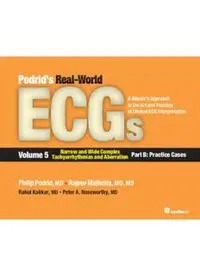
Podrid’s Real-World ECGs: A Master’s Approach To The Art And Practice Of Clinical ECG Interpretation, Volume 5B PDF
Preview Podrid’s Real-World ECGs: A Master’s Approach To The Art And Practice Of Clinical ECG Interpretation, Volume 5B
Podrid’s Real-World A Master’s Approach to the Art and Practice of Clinical ECG Interpretation Narrow and Wide Complex Volume 5 Tachyarrhythmias and Aberration Part B: Practice Cases Philip Podrid, MD Rajeev Malhotra, MD, MS Rahul Kakkar, MD Peter A. Noseworthy, MD Podrid’s Real-World ECGs A Master’s Approach to the Art and Practice of Clinical ECG Interpretation Volume 5 Narrow and Wide Complex Tachyarrhythmias and Aberration—Part B: Practice Cases Philip Podrid, MD Rahul Kakkar, MD Professor of Medicine Massachusetts General Hospital Professor of Pharmacology and Experimental Therapeutics Harvard Medical School Boston University School of Medicine Boston, Massachusetts Lecturer in Medicine Harvard Medical School Peter A. Noseworthy, MD Boston, Massachusetts Massachusetts General Hospital Attending Physician Harvard Medical School West Roxbury VA Hospital Boston, Massachusetts West Roxbury, Massachusetts Rajeev Malhotra, MD, MS Instructor in Medicine Cardiology Division Massachusetts General Hospital Harvard Medical School Boston, Massachusetts Minneapolis, Minnesota © 2016 Philip Podrid, Rajeev Malhotra, Rahul Kakkar, and Peter A. Noseworthy Due to ongoing research, discoveries, modifications to medicines, equipment and devices, and changes in government regulations, the information contained in this book Cardiotext Publishing, LLC may not reflect the latest standards, developments, guidelines, regulations, products or 3405 W. 44th Street devices in the field. Readers are responsible for keeping up to date with the latest Minneapolis, Minnesota, 55410 developments and are urged to review the latest instructions and warnings for any USA medicine, equipment or medical device. Readers should consult with a specialist or www.cardiotextpublishing.com contact the vendor of any medicine or medical device where appropriate. Additional information or any updates to this book may be found at: Except for the publisher’s website associated with this work, the publisher is not www.cardiotextpublishing.com/podrid-ecg-interpretation-v5-complex-tachyarrhythmias affiliated with and does not sponsor or endorse any websites, organizations or other Comments, inquiries, and requests for bulk sales can be directed to the publisher at: sources of information referred to herein. Podrid’s Real-World ECGs—The Complete Series Podrid’s Real-World ECGs: A Master’s Approach to the Art and Practice of Clinical ECG Interpretation Volume 1 The Basics Volume 2 Myocardial Abnormalities Volume 3 Conduction Abnormalities Volume 4 Arrhythmias Part A: Core Cases Part B: Practice Cases Volume 5 Narrow and Wide Complex Tachyarrhythmias and Aberration Part A: Core Cases (with introductory text) Part B: Practice Cases Volume 6 Paced Rhythms, Congenital Abnormalities, Electrolyte Disturbances, and More For more information about the other volumes in the series, please visit cardiotextpublishing.com Practice Cases Practice Case 6X2X man is brought to the emergency department having been found A unconscious. Prior to his arrival, the emergency medical technicians faxed a 12-lead ECG to you (ECG 62A). The history they relay on route is that of a 68-year-old man with a history of a remote myocardial infarction who was found by his family unconscious on the floor of his apartment. He had been well the morning of presentation. ECG 62A 2 Practice Case X6X2 He was treated in the field based on the ECG provided. Initial What is your interpretation of his initial ECG? vital signs were notable for a tachycardia and hypotension, and after appropriate therapy, his vital signs stabilized. He was intubated What arrhythmia diagnosis is suggested? prior to arrival. Upon admission to the emergency department, a repeat ECG is What clinical diagnosis is suggested in obtained (ECG 62B). comparing the two tracings? ECG 62B 3 Podrid’s Real-World ECGs ^ ^ ^ ^ ^ ECG 62A Analysis: Ventricular tachycardia (sustained monomorphic) 4 Narrow and Wide Complex Tachyarrhythmias and Aberration—Part B: Practice Case 62 ECG 62A shows a regular rhythm at a rate of 220 bpm. The QRS uniform, as the activation of the ventricle follows the same pathway complex duration is increased (0.18 sec), and the morphology is not each time. Thus, every QRS complex and ST-T wave is the same. In typical for either a right or left bundle branch block. Although there ventricular tachycardia, the activation of the left ventricle is not are no obvious P waves seen, there are inconsistent abnormalities of using the normal His-Purkinje system, but rather an alternative the ST-T waves, best seen in leads I (Ĺ) and V1 (Ļ). The variability in pathway that results in direct ventricular activation. The activation the ST-T waves may be due to superimposed P waves or may be differ- sequence may be variable, accounting for differences in the QRS com- ences in repolarization. There is also variability in the QRS complex plex. The abnormalities in ventricular depolarization is associated morphology seen in lead V1 (ࠬ). Such variability is not seen in a supra- with abnormalities in ventricular repolarization, accounting for the ventricular tachycardia in which depolarization and repolarization are ST-T wave changes. continues 5 Podrid’s Real-World ECGs + + W W + + ^ + + + W + ^ + + + + ECG 62B Analysis: Normal sinus rhythm, right atrial hypertrophy (abnormality), first-degree AV block (prolonged AV conduction), old lateral and anteroapical myocardial infarction, left ventricular aneurysm, low voltage in limb leads 6
